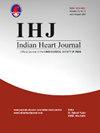Safety and one-year follow-up analysis of percutaneous ASD closure at a tertiary care hospital
IF 1.8
Q3 CARDIAC & CARDIOVASCULAR SYSTEMS
引用次数: 0
Abstract
Aim
This study was designed to evaluate the safety and effectiveness of the Cocoon Septal Occluder device (Vascular Innovations Co. Nonthaburi, Thailand) for transcatheter closure of isolated secundum type atrial septal defect (ASD) in Indian patients.
Methods
This was a single-center, retrospective, observational study which included patients who underwent transcatheter closure of isolated secundum ASD using the Cocoon Septal Occluder between April 2014 and May 2023. Follow-up assessments up to one-year were conducted through review of hospital medical records, clinic visits, or via telephonic communication with primary care physicians.
Results
A total of 400 patients were included in the study, consisting of 28 paediatric (aged ≤15 years, 8.14 ± 4.41 years) and 372 adult patients (40.83 ± 13.23 years). The mean defect diameter and device size were 16.75 ± 5.85 mm and 20.43 ± 6.24 mm for paediatric patients, and 21.62 ± 6.87 mm and 24.94 ± 7.28 mm for adult patients, respectively. The device was successfully implanted in all paediatric patients, achieving 100 % closure of the defect with no complications, which persisted through one-year follow-up. In the adult cohort, complete ASD closure was achieved in 99.2 % of patients, with two cases of device embolization and one case of device withdrawal. At one-year follow-up, adult patients experienced 0.3 % late device embolization, 0.8 % pericardial effusion/cardiac tamponade, 0.5 % atrioventricular block, and 0.5 % atrial flutter/fibrillation. No cases of endocarditis, haemolysis, nickel allergy, stroke/transient ischemic attack, or migraine were reported in either paediatric or adult patients.
Conclusion
The results demonstrate that Cocoon Septal Occluder is safe and effective in closing isolated secundum ASD during one-year follow-up.

一家三级医院经皮ASD闭合术的安全性和1年随访分析。
目的:本研究旨在评估Cocoon Septal Occluder装置(Vascular Innovations Co. Nonthaburi, Thailand)用于经导管封闭孤立性房间隔缺损(ASD)的安全性和有效性。方法:这是一项单中心、回顾性、观察性研究,纳入了2014年4月至2023年5月期间使用Cocoon Septal Occluder经导管封闭孤立性房间隔缺损(ASD)的患者。通过审查医院医疗记录、诊所就诊或通过与初级保健医生的电话交流,进行了长达一年的随访评估。结果:共纳入400例患者,其中儿童28例(年龄≤15岁,8.14±4.41岁),成人372例(40.83±13.23岁)。小儿平均缺损直径为16.75±5.85 mm、20.43±6.24 mm,成人平均缺损直径为21.62±6.87 mm、24.94±7.28 mm。该装置成功植入所有患儿,缺损100%愈合,无并发症,随访1年。在成人队列中,99.2%的患者实现了ASD完全闭合,其中2例器械栓塞,1例器械退出。在一年的随访中,成年患者出现了0.3%的晚期器械栓塞、0.8%的心包积液/心包填塞、0.5%的房室传导阻滞和0.5%的心房扑动/颤动。在儿童或成人患者中没有报告心内膜炎、溶血、镍过敏、中风/短暂性脑缺血发作或偏头痛的病例。结论:在1年的随访中,本研究结果表明,茧间隔闭塞器对孤立性继发性ASD是安全有效的。
本文章由计算机程序翻译,如有差异,请以英文原文为准。
求助全文
约1分钟内获得全文
求助全文
来源期刊

Indian heart journal
CARDIAC & CARDIOVASCULAR SYSTEMS-
CiteScore
2.60
自引率
6.70%
发文量
82
审稿时长
52 days
期刊介绍:
Indian Heart Journal (IHJ) is the official peer-reviewed open access journal of Cardiological Society of India and accepts articles for publication from across the globe. The journal aims to promote high quality research and serve as a platform for dissemination of scientific information in cardiology with particular focus on South Asia. The journal aims to publish cutting edge research in the field of clinical as well as non-clinical cardiology - including cardiovascular medicine and surgery. Some of the topics covered are Heart Failure, Coronary Artery Disease, Hypertension, Interventional Cardiology, Cardiac Surgery, Valvular Heart Disease, Pulmonary Hypertension and Infective Endocarditis. IHJ open access invites original research articles, research briefs, perspective, case reports, case vignette, cardiovascular images, cardiovascular graphics, research letters, correspondence, reader forum, and interesting photographs, for publication. IHJ open access also publishes theme-based special issues and abstracts of papers presented at the annual conference of the Cardiological Society of India.
 求助内容:
求助内容: 应助结果提醒方式:
应助结果提醒方式:


